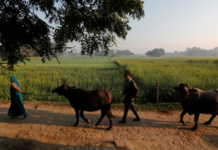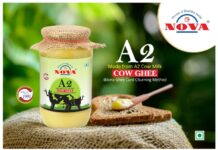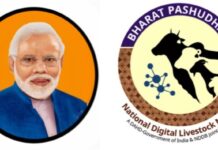By Dr. Shanker Suwan Singh, Columnist and Thinker, Assistant professor, Agriculture University, Prayagraj (Uttar Pradesh)
In South East Asia, milk is found in goat and sheep milk. Its time is from 7 to 8 thousand years before Christ. In Europe, the description of milk is found from 4 to 5 thousand years before Christ. Milk is an energy-rich diet. Milk provides instant energy to the body. Milk contains amino acids and fatty acids. Milk is a complete diet. Life is incomplete without milk. Milk is an opaque white liquid made by the milk glands of females. The newborn is dependent on milk until he is unable to consume other substances. The ingredients present in milk are water, solids, fat, lactose, protein, mineral fat, and without solids. If we talk about water present in milk, the maximum water is 91.5% in milk of cow, 90.1% in mare, 87.4% in humans, 87.2% in cow, 86.5% in camel, 86.9% in goat. Milk contains calcium, magnesium, zinc, phosphorus, iodine, iron, potassium, folates, vitamin A, vitamin D, riboflavin, vitamin B-12, protein, etc. Cow’s milk contains 3.14 milligrams of cholesterol per gram is. Cow’s milk is thin, which is easily digested in the body.
According to Sukumar Dey: Definition of milk “Milk is a complete, clean, lacteal secretion derived from the full feeding of healthy milch animals, fed and kept properly, which is achieved within 15 days. It is obtained 5 days after and after calming down. Milk is the cleanest food for us from a nutritional point of view. The body needs more than thirty specific ingredients in the food supply. Not a single food supplies all. , But milk supplies almost all. ”
According to Ayurveda, only fresh cow’s milk is considered good. In the Purana, milk has been compared to nectar, which makes the body healthy and at the same time prevents many diseases. It is written in the Atharva-veda that milk is a complete food item. It has all the elements necessary for the human body that our body needs. In the sixth mantra of the 71st Sukta of the first mandal of the Rig Veda it is said: Goshu Priyam Amritam Rakshamana (Rigveda 1/71/6) It means Goddess nectar is it protects us from diseases (diseases). Charak Shastra is the oldest medicine in the world.
It is counted in the scriptures. The qualities of milk are described in the Charaka Sutra place 27/224 (1.Sutrasthanam, 27. Annapanavidhyadhyay (section / section / mandal-1, chapter / chapter / sukta 27, richay / verses 217-224) as follows – Svastu Cold Soft Snigdham Bahln Shlakshanpichilam | Guru Mandand Prasanna Gavya Dasagunam Payah Thus it increases the oozus with similar properties due to its similarity. Therefore, cow’s milk is said to be the best as a power enhancer and ooze. Buffalo milk is heavier and colder than a cow. Milk is easy to digest. Camel milk is rough, warm, slightly salty, light and is prescribed for vata kapha. Milk of one-hoofed animals (such as mare, donkey, etc.) promotes strength, stability It is warm, slightly sour, saline, rough, mild and reduces vata in the extreme. Goat’s milk is astringent-sweet, cold, astringent, mild. It also causes internal bleeding, diarrhea, wastage, cough and fever. Removes salt. Sheep milk produces hiccups and indigestion. It heats up and increases bile and phlegm. The milk of elephants (female) promotes strength. It is heavy and a good stabilizer. Cow’s milk is a great way to increase the beauty and health of the body. Cow’s milk and ghee are very important for health. Cow’s milk keeps humans away from diseases.
Buffalo milk contains 0.65 milligrams of cholesterol per gram. Buffalo milk has 92 percent calcium, 37 percent iron and 118 percent more phosphorus than cow’s milk. According to the Indian Spinal Injury Center there is better buffalo milk than cow’s milk. It contains less cholesterol and more minerals. Buffalo milk strengthens weight and muscle. According to Ayurveda, people who go to the arena / gym are the best for them. Packaged milk of various companies is also available in the market. Packaged milk – supplied by companies like Mother Dairy, Amul, Parag, Namaste India, Shyam Dairy. Vitamin A, iron and calcium are also added from above. It also has many types like full cream, toned, double toned and flavored milk. Full cream has full cream, so fat is the highest. All these have their utility, but according to the opinion of the doctors, full cream milk is better for children and less fat milk for the elders.
Man’s practice of cow’s milk started when he left the life of the tribes and stayed in one place and started farming. Sugar in milk is called a lactose. In children, the lactase enzyme has the power to digest lactose. Adults do not have the power to digest lactose. Later on, the power to break down lactose developed in adults too. Adults also started using milk. South-eastern countries do not have lactase enzyme to break down lactose. That is, such people do not have the power to digest milk. While the people of North India, Europeans, Americans, Russians etc. have the power to digest milk by adult humans. Louis Pasteur’s pasteurization principle was used to keep the milk sweet and pure. Pasteurization, a heat-treating process that destroys pathogenic microorganisms in certain foods and beverages. Pasteurization of milk is widely practiced in many countries. Pasteurizing milk requires more time and a lower temperature, with a temperature of about 63 degrees centigrade (145 degrees F) and up to 30 minutes. Or alternatively, shorter times and higher temperatures are required, with temperatures up to 72 ° C (162 ° F) and up to 15 seconds. Time and temperature are necessary to destroy Mycobacterium tuberculosis and other non-spore-forming microorganisms found in milk.
The pasteurization process helps in eliminating the harmful bacteria in the milk. Industrialization has made rapid progress in the milk business in the late 19th and early 20th centuries. When the milk goes into the plant, it is first homogenized so that the fat particles of the milk become of the same size. This process is called homogenization. Types of Milk- (a) Whole milk- Milk obtained from a healthy animal which has not undergone solid changes in its composition is called whole milk. This type of milk is called cow, goat, buffalo milk. The minimum amount of fat and fat-free solids in whole milk is kept at 3.5% and 8.5% in cow and 6% and 9% in buffalo respectively. (B) Standard milk – This milk in which the amount of fat and fat-free solids is cream from milk. Tax milk has a minimum fat content of 4.5% and fat-free solid 8.5%. (C) Tond milk- Tand milk is obtained by mixing water and fresh milk powder in whole milk, with a fat content of 3% and fat-free solid determined as 8.5%. (D) Double-toned milk- The fat in this milk is fixed at 1.5% and fat-free solid 9%. (E) Reconstituted milk – When milk powder is dissolved in water, milk is prepared in which 1 part Reconstituted milk is added to milk powder and 7 to 8 parts of water. (F) Recombined milk – This milk which is prepared by mixing butter oil, suppress milk powder and certain quantity of water is called recombined milk. In which the fat content has been fixed at 3% and the amount of fat-free solids is 8.5%. (G) Filled milk – When milk fat is removed from whole milk and vegetable fat is added in its place, it is called field milk.
The following foods are made from milk, khoya, shrikhand, cream, butter, ghee, curd, yoghurt, cheese, cheese, rabri, ice cream, etc. India ranks first in milk production in the world. World Milk Day is celebrated on 1 June every year since 2001. This time is the 20th anniversary of World Milk Day. The day provides an opportunity to focus on activities related to the dairy sector. The day provides an opportunity for people to focus on milk and publicize activities related to milk and dairy industries. Through the importance of milk, World Milk Day impacts large population through this festival. The whole world is suffering from the corona (Kovid-19) epidemic. So far, no exact medicine has been made nor any vaccine. There is no hope in this epidemic where turmeric milk has increased the confidence of the people. In this epidemic, people have increased their immunity by using milk and turmeric. As it is said that prevention / precautions and immunity play an important role in fighting this epidemic.
The production of milk in India is 140 million liters but consumption is 64 million liters. This proves that adulteration in milk is on a large scale Has been There have been more cases of adulteration of milk in northern states than in southern states. A few years ago there was a survey in the country regarding adulteration of milk. It was found that while packing the milk is played with both cleanliness and hygiene. Direct adulteration of detergent was found in milk. This adulteration proved to be a direct threat to people’s health. Due to this, the body parts of consumers can stop functioning. The World Health Organization issued an advisory to the Government of India against adulteration of milk and said that if adulteration in milk and milk products is not controlled, around 87 per cent of the population of the country will have a dangerous and fatal disease like cancer by 2025. May be a victim of We should not forget that “the health of the nation’s community is its property.” Therefore, on World Milk Day, India needs to think about adulteration in milk and to overcome this, the Government of India needs to formulate a solid strategy. So that the health of the people of India cannot be played with and the pure milk can reach the people. If milk is not adulterated, then it would not be surprising to say that milk is the basis of global food. Milk dependence strengthens global health. Therefore, dependence on milk signifies global health.
Corporate Comm India (CCI Newswire)



















![Poolani Milk Cooperative Society [PMCS] well-established and fastest-growing in the Dairy Sectorof RuralKerala](http://thedairytimes.com/wp-content/uploads/2024/04/1-218x150.jpg)









![Poolani Milk Cooperative Society [PMCS] well-established and fastest-growing in the Dairy Sectorof RuralKerala](http://thedairytimes.com/wp-content/uploads/2024/04/1-100x70.jpg)